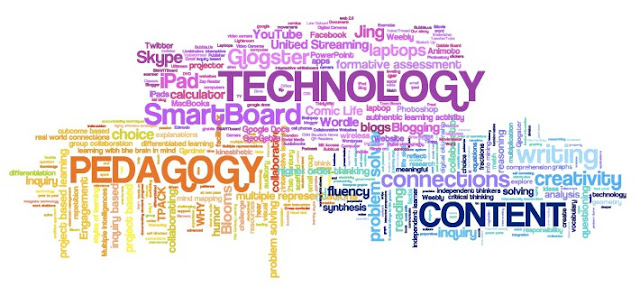This post is Part TWO of a four-part series titled Model Mayhem where I am exploring and critiquing different models of tech integration. For each model I will provide a general overview of the model, what it might look like in a classroom setting, and attempt to critique the pedagogical theory and foundations behind the model's development.
The first model of the series was the SAMR model, a four-step model of tech integration designed to improve student outcomes, developed by Dr. Ruben Puentedura. You can read all about that post by clicking HERE.
The second model of the series that we will be discussing today is the TPACK or TPCK model, a three-component model of tech integration designed to identify the knowledge required by teachers to integrate technology in their classrooms; built off the work of Lee Shulman.
_______________________________________________________
GENERAL OVERVIEW
 |
| TPACK. (2012). Uploaded by Koehler and Mishra. Available online at: http://tpack.org/ |
 |
| TPACK World Cloud. (2013). Uploaded by ilborukedtech. Available online at: https://lborukedtech.files.wordpress.com/2013/02/tpack2.jpg Short video introduction of the TPACK Model Full length slides & lecture of the TPACK Model |
Teaching Creatively: Teachers as Designers of Technology, Content and Pedagogy from Punya Mishra on Vimeo.
_______________________________________________________
APPEARANCE IN THE CLASSROOM SETTING
 |
| Beginning with the End in Mind. (Accessed 2017). Uploaded by Tracy Clark. Available online at: https://www.smore.com/w1cj-tpack-as-a-model-for-change |
 |
| TPACK Game. (Accessed 2017). Uploaded by Public Schools of North Carolina. Available online at: http://ncltitpack.ncdpi.wikispaces.net/RePack+Your+TPACK |
 |
| Integrated TPACK in Teacher Education Program. (2015). Uploaded by Gur and Karamete. Available online at: http://www.academicjournals.org/journal/ERR/article-full-text/068A05B51888 |
_______________________________________________________
PEDAGOGICAL THEORY AND FOUNDATIONS
Concept Development Timeline*
- 2001
- Pierson uses the term TPCK to describe teacher's technology integration
- 2005
- Koehler & Mishra use the term to describe a knowledge-base for teachers using technology
- Niess uses the term to refer to technology-enhanced PCK
- 2009
- Angeli & Valanides argue that TPCK is a unique knowledge-base unto itself rather than growth in the three domains
contributing the TPCK as described in 2005
- Cox & Graham argue that technology has always been a part of Shullman's original PCK model
- 2011
- Bowers & Stephens argue that TPACK is more about a teacher's orientation towards technology than a fixed knowledge
base
*Timeline based on research from Voogt, J., Fisser, P., Pareja Roblin, N., Tondeurt, J., & van Braakt, J. (2012). Technological pedagogical content knowledge - a review of the literature. Journal of Computer Assisted Learning. Retrieved October 10, 2017 from, https://ai2-s2 pdfs.s3.amazonaws.com/fc67/9e00468ed22c40d11bcd84aae0462c40d89c.pdf
Influences
Educational Philosophy
When looking at the TPACK model as a way to describe the knowledge required by teachers to successfully incorporate technology I would argue that TPACK tends to follow a essentialism educational philosophy. I say this because the three realms are shown as essential skills for educators to have and a mastery of these concepts, in balance, showcases the "great teaching" that can occur. The venn diagram approach is systematic, has clear symmetry, and provides practicality for users; all of which model aspects of an essentialism philosophy.
When looking at the TPACK model and the impact appropriate technological integration has on students I would argue that TPACK tends to follow a progressivism educational philosophy. I say this because the ever-changing nature of technology and emphasis on individual classroom/student contexts echoes Dewey's focus on an ever-evolving reality for students. The use of technology opens up increased opportunities for multi-media platforms and interdisciplinary approaches to subject manner; all of which model aspects of a progressivism educational philosophy.
Ornstein, A. C., & Hunkins, F. P. (2013). Curriculum: foundations, principles, and issues. New Jersey, US: Pearson Education.
_______________________________________________________
PERSONAL THOUGHTS
When comparing the TPCK/TPACK model to my critique of the SAMR model I appreciate the various sources of information that I can find explaining the model and the theories behind it, from the TPACK website itself to a host of many peer-reviewed scholarly articles.
I am a fan of how this model accounts for the three realms of content, pedagogy, and technology and emphasizes that "great teaching" can occur when all three are accounted for. I agree with the Common Sense Media video I embedded above when they say that it is easy to get excited about a new technology and how some educators begin designing lessons around the technology rather than accounting for content and pedagogy first. I believe the TPACK model can help alleviate some of the frustration educators find when they rush into using a technology simply for the sake of using technology and then find it is not working for their specific classroom context. If content and pedagogy drive the purpose of using a technology then classroom integration should function much more smoothly than if we try to use a technology just to say we used it.
Unfortunately, I feel as though my B.Ed degree and most PD I have attended tend to focus on either content, pedagogy, or technology and not necessarily how to use these realms simultaneously. Alternatively I feel like many educators have a strong PCK or TCK but much of our formal training in pedagogy or our pedagogy experiences have not involved the technology we have access to today. Understanding the TPC realm and how it has to shift from a more traditional approach can be a big undertaking for some educators.